Agracid S vs Competitor’s Product Technical Evaluation
Published: November 4, 2014
By: Marco Aurélio Callegari
1. Introdution
Rearing Brazilian pig presented in the last decades a significant increase in productivity, a result attributed to several factors, including the low age of weaning practiced (WALSH et al., 2007b).
Weaning, however, is still considered a critical step for piglets given to various stressors they are exposed to, how social changes (are separated from the sow), environmental (change locations) and nutritional (stop eating breast milk, which is physiologically accessed 60-90 minutes and begin to eat solid food ad libitum). One of the most important aspects of post-weaning piglet is the inability to satisfactory adaptation to the new diet.
The lack of adequate digestive enzymes in this phase results in a low digestion of nutrients (CORASSA et al., 2006) and therefore increases the osmolarity of the contents of the digestive tract, causing osmotic diarrhea. In the post-weaning period, with limited feed intake and the action of harmful bacterial (UTYAMA et al., 2006), the structures of the gut are damaged, resulting in villous atrophy, due to the greater increase in the rate of epithelial desquamation and increasing the depth of the crypts to ensure proper rate of cell renewal and ensure the replacement of lost cells of the apical region (OETTING et al., 2006).
Also piglets in post-weaning stage have a limited capacity to secrete HCl, which can result a high gastric pH (Roth, 2000). Moreover, the buffering capacity of the food may interfere with the stomach pH, which would require an increase in the amount of HCl needed to acidify it.
The organic acids and their salts are currently presented as an alternative to reducing gastric pH (Miguel et al. 2011).
Therefore, the phase of weaning can be considered critical, since the high stomach pH is unfavorable, thus it impairs increases gastric digestion the risk of the development of pathogenic flora and diarrhea (LI et al., 2008).
In this context the organic acids also have an interesting effect. Organic acids non-dissociated can diffuse passively through the cell wall of bacteria, dissociating in the cytoplasm and thus promoting the decrease in internal pH. The H+ ions are responsible for this reduction, determining a compatible framework for certain bacteria, which cannot tolerate a different pH gradient on both sides of the membrane (SURYANARAYANA et al. 2012), generating positive effects on pathogenic microflora (PIVA et al., 2007b) through the bactericidal or bacteriostatic (BASSAN et al., 2008).
Organic acids have been one of the promising in replacement by antibiotics in diets for piglets that due to growing concern about the development of resistance among pathogens and the occurrence of these residues to consumer’s alternatives led the European Union to ban their use. The United States, in the same shed, set a deadline of three years for pharmaceutical industries to establish a plan for withdrawal of antibiotics as growth promoters (NUNES, 2013).
The mechanisms of action of organic acids, preserved some controversies, include direct antimicrobial activity with increasing pepsins by reducing the pH of the feed and the gastric contents and the antimicrobial action of the anion, as well as serving as a source of energy (FUENTE et al ., 2005).
The aim of this study was to evaluate the effects of supplementation of commercial blends with organic acids microencapsulated associated with essential oils and salts of acids on performance, control of diarrhea and its action on the parameters of quality and efficiency digestive tract of weaned piglets.
2. Materials and methods
The performance trial was conducted at Sector Swine Farm School, State University of Londrina - Paraná. Were used 72 piglets (Pen Ar Lan), castrated males and females from a commercial farm with twenty-three days of age, with the average body weight of 6,00 kg ± 1,2 kg. Was used 24 masonry stalls, distributed in two rows, with 2.97 m2 area each bay, separated by brick walls with a height of 0.80 m were used. Concrete stall and floor, covered wood shavings was used. In the first two weeks of the trial period wooden feeders (0.30m x 0.09m) that were later replaced by metal semi-automatic feeders were used.
The animals were fed the experimental diets and water ad libitum throughout the experiment.
The treatments consisted of two formulations, iso nutrients and isocaloric, one as control and two blends of organic acids diets were formulated to meet the minimum requirements for piglets with high genetic potential with higher performance requirements, three phases, pre starter (23 - 37 days), starter I (38 - 51 days) and starter II (52 to 63 days), was used pre starter, 0,700 kg/ton, starter I 0,600 kg/ton and starter II 0,600 kg/ton T2 Agracid S; Competitor product was used in three stages 2.0 kg/ton, T3 and T1 control (free of organic acids).
Fatty Acids analysis was performed FUNEP- Foundation to support research, education and extension Address: V-AC PRF. PAULO DONATO CASTELANI, 0 (CAMPUS UNESP - JABOTICABAL-SP).
Microbial counts were performed at the Laboratory Laboratory Mercolab Mercolab, Cascavel - PR-Brazil.
The aim of this study was evaluate the performance, diarrhea incidence, flow rate, stomach and small intestine pH contents, volatile fatty acids in cecum, morphology of the duodenum, jejunum and ileum, microbiological score, organs morfometry.
Experimental Unit of State University of Londrina.
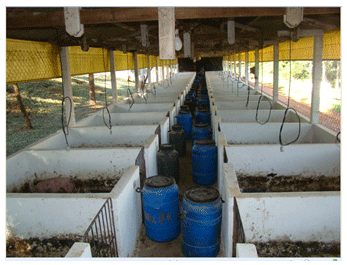
Microbial counts were performed at the Laboratory Mercolab, Cascavel - PR-Brazil.
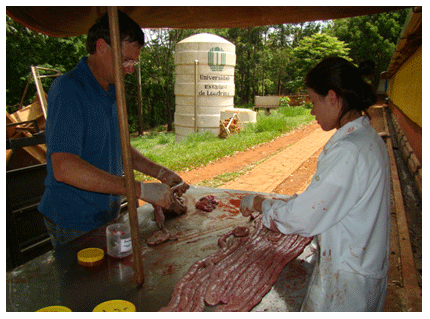
3. Results
3.1. Performance
The results obtained from the performance assay are shown in Table 1.
Table 1: Body weight gain (BWG), diary feed intake (DFI), feed conversion ratio (FCR), final average weight (AW) according to experimental phases. Values in expressed in kg.

The results were different from those observed by Santos (2010), who used a microencapsulated product containing fumaric and malic acid with different concentrations of essential oils for piglets in the nursery phase. The author observed differences in feed efficiency of animals receiving the additive, but found that in a minor amount of organic acids and higher amounts of essential oils showed better rates of weight gain.
Regarding the use of blends of microencapsulated acids Piva et al. (2007a) reported that their use can reduce by 10 times the inclusion of acids in free form minimizing possible damage worsens acids on feed intake. However, this behavior was not observed in this work. Along the same line, Grilli et al. (2010) found that a diet containing microencapsulated organic acids determined optimum performance of piglets in the nursery phase. However, these results did not identify with the values obtained in this experiment.
To Freitas et al. (2006) the response of acidifiers on performance is a function of their level of inclusion in the diets. In turn, Lawlor et al. (2006) treat the performance responses to supplementation acids are associated with the type of acid, the level of inclusion of these, phase the animal growth and health status of piglets.
Was noted that we found no difference between treatments, the Agracid S (T2) got the same result presented by Competitor (T3), which was similar to the treatment without acids (T1), leads us to the hypothesis that there are a number of others to acids that can mask the effects factors involved. On this way, the results may have been affected by the environment, which did not correspond to that of a commercial farm, and may, because of a lower health challenge, besides the intense handling treatment applied 4 times during the day did not affected in consumption and in responses of additives. Lactose levels in the diet also used might have influenced the good performance of animals fed diet without acids.
Reduction in feed intake not was observed , which was vital to the performance of the lots, contrary to the observation of Walsh et al., (2007b), which reported a reduction in consumption when was the combined use of acids were observed in diet and in drinking water, this being due to worsening of palatability due to high levels of acids.
Thus, the divergence of results between searches using acids to piglets from daycare is probably due to variations in experimental conditions, such as nutritional quality of the diets, the level of addition of acidifying and the level of environmental challenge and the health status of animals.
3.2 Diarrhea incidence
The diarrhea score (Table 2 and graphic 1), it was observed that piglets fed the diet without added organic acid (T1) had a higher incidence compared with other treatments.
Table 2: Percentage of animals with diarrhea in pre-initial period 0-14 days, fed with different blends of organic acid.

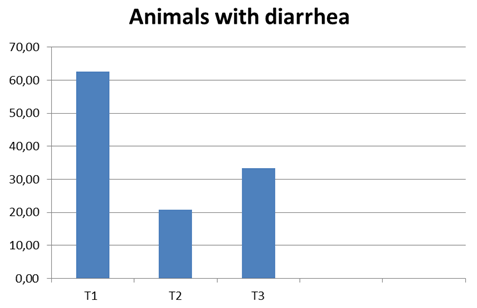
According to Braz (2008), the high frequency of diarrhea at this stage due to the immaturity of the digestive and immune systems of piglets. Diarrhea can also occur by the presence of undigested food waste and not absorbed that serve as substrate for pathogenic micro-organisms.
It is observed that piglets fed blends of organic acid (T2 and T3) had less diarrhea (fewer animals had the development of the framework) and in the shortest time interval is restored, identifying himself with the observation made by Freitas et al. (2006).
Corassa, Bellaver (2012), obtained results different from who worked with citric acid and sorbic, and Miguel et al. (2011), who used diets with various organic acids (diformiato potassium, fumaric acid, citric acid, benzoic acid) found no benefit for the control of diarrhea with the use of these acids, assigning other factors engagement with the frame.
The treatment comprises of the blend with organic oils and essences acids with lesser dose than the other treatments showed if successful in controlling diarrhea, indicating the synergistic effect of essential oil with organic acid (PIVA et al., 2007b).
3.3 Flow rate
In Table 3 are demonstrated the flow rate obtained in minutes.
Table 3: Flow rate of the diet according to the tratments

In face of results, the blends of acids did not affect the transit time of the diet, even in treatments that resulted in reduction of stomach pH, contradicting the hypothesis that the acidification can affect the rate of gastric emptying, a mechanism of quantitative and qualitative control of microflora and also the mixing of digestiv process (PEÑACOBA, 2002). The reduction of gastric pH results in shorter transit time and increased gastric retention due to increased proteolytic enzyme activity (Costa et al., 2013). Changes in protein digestion in the stomach may affect the flow of the diet into the lower gastrointestinal tract by modifying the intestinal microflora and fermentation promoting changes in the protein that reaches the small intestine, leading to changes in intestinal transit time (BRAZ et al., 2011). However, Smith (2008) using blends of organic acids, reports no difference in stomach pH, but Piva et al. (2007a) and Gomes et al. (2011) found a reduction of stomach pH when added organic acids in the diet.
Manzanilla et al. (2004) observed that diets based essential oils pepper, slow the rate of passage through the effect of capsaicin, increasing the time of digesta in the stomach, acting as a barrier to pathogens, producing possible beneficial effects on the digestive ecosystem without affecting digestion. However, in the treatments containing essential oils, this effect was not evident. Reduction in gastric pH is increased retention time has been difficult to be demonstrated, whereas the improved apparent ileal digestibility of protein and amino acids were observed with growing pigs, but not in weaned piglets (Partanen, MROZ 1999) .

3.4 Stomach and small intestine pH contents
As for the mean pH values of stomach contents and small intestine (Table 4), 40 days after the beginning of the experiment, we note that there were differences between treatments with T3 diet, with lower pH, should also be considering that the blends acid were microencapsulated, showing that the process medium chain fatty acids protect acids dissociate in the stomach, past coupled to the small intestine. However, this possibility of changing the pH in the small intestine was not confirmed.
Table 4: pH of the stomach contents and the contents of the small intestine of piglets fed the different blends of organic acids on the end of the experiment.

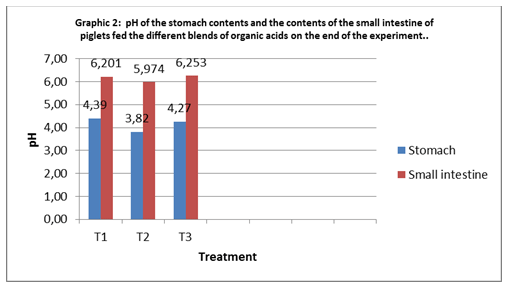
A factor limiting the use and effectiveness of these are acid is absorbed very quickly after leaving the stomach. Piva et al. (2007b), working with weaned piglets, no significant differences in pH of the stomach when they added a mixture of organic acids and plant extracts microencapsulated by checking only difference in the caudal portion of the jejunum, the highest pH in the diet has not received the product.
Many studies show that it is practically impossible to significantly change the pH of the stomach and intestine of a pig, even when large amounts of organic acids are used in animal feed (Corassa; Bellaver, 2012).
Costa et al. (2013) reported that comparisons between the studies aimed at determining the reduction in gastric pH of animals receiving organic acids because of the wide variation in the methods and difficulty of measuring pH in the stomach. Another hypothesis is that at slaughter contamination of the contents of the stomach with saliva or duodenal contents, which tends to increase gastric pH by introducing alkaline substance may occur in the stomach (BRAZ et al. May 2011).
3.5. Volatile fatty acids
About the analysis in cecum content (Table 5), it was observed that the treatments affected the production of acetic, propionic and butyric where the control diet showed a lower concentration of this, compared to other treatments. Acids showed a higher concentration for the T2 treatments compared to the control, and T3. The production of valeric acid was not affected by diets.
Table 5: Concentration in mmol/L of volatile fatty acids in cecum in the end of experiment.

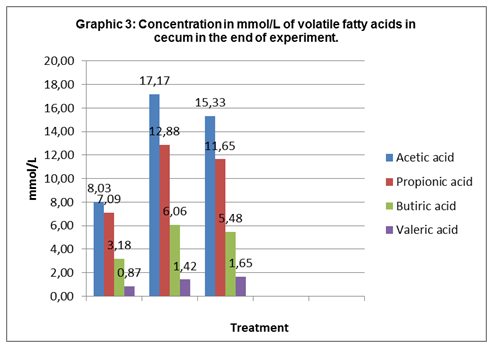
Whereas essential oils and organic acids have a modulating effect on the microbial population of small and large intestines (SURYANARAYANA et al., 2012) is expected to cause a change in the pattern of VFA, especially essential oils and acids when microencapsulated organic therefore can better reach the large intestine.
Willamil et al. (2011) showed that the organic acids microencapsulated have the ability to modify the cecal fermentation. The use of a blend of microencapsulated organic acid in the diet improved the fermentation in the large intestine of piglets in treatment compared to control, resulting in the increased production of VFAs (GRILLI et al. 2010). Thus, the addition of sodium formate or benzoic acid or fumaric acid is not encapsulated in the diet of piglets 56 days of age showed no difference in the cecum, but showed variation of this AGV in the duodenum and ileum (KASPROWICZ-POTACKA et al. , 2009), indicating greater bacterial fermentation in these portions of the tract. We observed that treatment resulted T2 greater VFA concentration, confirming the hypothesis that association of the organic acid improves bacterial fermentation in the cecum. Also can be assign the blend of microencapsulated organic acids (T3) reached the cecum, improving bacterial fermentation.
3.6 Morphology of duodenum, jejunum and ileum
Regarding the morphometric values of the small intestine (Table 6) for villous height, there was a difference in the duodenum and jejunum and ileum for treatments T2 in favor of the treatment group compared to the control treatment T1 and T3. Villus:crypt was no difference in the duodenum, jejunum and ileum with advantage for the treatment T2 compared to T1 and T3 treatments.
Table 6: Average height (µm) of the villi (AV) of the crypt depth (PC), the ratio of villus height/crypt depth (VH / CD) measures duodenum at the end of the experiment. (amounts expressed in microns)

The results favor the T2 treatment compared to the control diet and the treatment T3, especially the height of the villi of the jejunum, a major producer of enzymes and absorptive region, identifying himself with the observations of Braz et al. (2011) who found that the best results in intestinal morphology, using a blend of organic acids. Nor was there any loss of acids on these parameters, contrary Gomes et al. (2007) different from that expected by the use of acidic effects observed that the addition of 1% of fumaric acid to butyric acid (0.1%) and formic (0.5%) in the diet of piglets at three week post-weaning caused damage at the time of the duodenum. In villus/crypt relation there was an improvement in the treatment compared to the control T2 and T3, showing an improvement in intestinal morphology.
3.6 Microbiological score
Microbiological counts are shown in Table 7. Difference was found between treatments Lactobacillus spp, Escherichia coli, Salmonella ssp and Clostridum was observed.
Table 7: Bacterial count of Lactobacillus spp, E. coli, Salmonella spp, Clostridium perfringens, according to the experimental treatments

The results are found by according to the Kasprowicz-Potocka et al. (2009), working with fumaric acid and the observed difference in the count Clostridium perfringens, Lactobacillus and E. coli, but differ as benzoic acid addition increased the population of Clostridium perfringens in stools in the cecum and duodenum.
3.8 Organs morphometry
In Table 8 it can be observed that there was no difference in the relative weight of the organs of the digestive system between treatments
Table 8: Organ weights in kg (stomach, small intestine and large intestine and the total weight of the organ)

The development of this organ according to the performance of the animals, where no significant difference in feed intake, a factor that could change the weight of these. According to Braz, (2007), isocaloric and isonitrogenous rations, and feed intake of animals between treatments were similar and they are not found difference in organ weights. The findings can be related to the theory that the organ weight changes with consumption of energy and / or protein (Bikker et al. 1995), a fact that confirms the hypothesis since the diets used were isonitrogenous and isocaloric.
4. Conclusion
The blends of organic acids were effective in controlling diarrhea in post-weaning period, this effect is attributed to the ability to act in the small intestine and large intestine, resulting in increased VFA production in the cecum, and improves intestinal morphology of treatment T2. The use of blends with essential oils, proving its synergism was effective even at lower, effective control of the effects of diarrhea and VFA production rates. These conditions may favor the economics of treatments and are positive in the diet formulation to minimize the inclusion of non-nutritional additives.
5. References:
BASSAN, J. D. L.; FLÔRES, M. L.; ANTONIAZZI, T.; BIANCHI, E.; KUTTEL, J.; TRINDADE, M. M. Controle da infecção por SalmonellaEnteritidis em frangos de corte com ácidos orgânicos e mananoligosssacarídeos. Ciência Rural, Santa Maria, v.38, n.7, p.1961-1965, 2008.
BELLAVER, C. Utilização de melhoradores de desempenho na produção de suínos e de aves. Concórdia: Embrapa Suínos e Aves, 2006. Disponível em: <http://www.cnpsa.embrapa.br/sgc/sgc_arquivos/palestras_d2t87d4m.pdf>. Acesso em: 5 abr. 2013.
BRAZ, D. B. Acidificantes como alternativas aos antibióticos melhoradores do desempenho de leitões na fase de creche. 2008. Dissertação (Mestrado em Ciência Animal e Pastagens) – Universidade de São Paulo, Piracicaba, 2008. Disponível em: <htth://WWW.teses.usp.br/teses/disponíveis/11/11139/tde-14052008-113209>. Acesso em: 27 abr. 2014.
CORASSA, A.; LOPES, D. C.; OSTERMANN, J. D.; SANFELICE, A. M.; TEIXEIRA, A. O.; SILVA, G. F.; PENA, S. M. Níveis de acido fólico em dietas contendo acido fórmico para leitões de 21 a 48 dias de idade. Revista Brasileira de Zootecnia, Viçosa, v. 35, n. 2, p. 462-470, 2006.
CORASSA, A., LOPES, D. C. BELLAVER, C. Mananoligossacarídeos, ácidos orgânicos. e probióticos para leitões de 21 a 49 dias de idade.Archivos de Zootecnia, Cordoba, v. 61, n. 235, p. 467-476, 2012.
COSTA, L. B., LUCIANO, F. B.; MIYADA, V. S.; GOIS, F. D. Herbal extracts and organic acids as natural feed additives in pig diets. South African Journal of Animal Science, Pretoria, v. 43, n. 2, p. 181-193, 2013.
FREITAS, L. S.; LOPES, D. C.; FREITAS, A. F.; CARNEIRO, J. C.; CORASA, A.; PENA, S. M.; COSTA, L. F. Avaliação de ácidos orgânicos em dietas para leitões de 21 a 49 dias de idade. Revista Brasileira de Zootecnia, Viçosa, v. 35, p. 1711-1719, 2006.
FUENTE, J. M.; FERNANDES, C.; BLANCH, A.; BACHA, F.; GARCILOPES, F. Aditivos zootécnicos: Alternativas a lós antibióticos como promotores de crescimento em porcino. In: CONGRESSO BRASILEIRO DE VETERINÁRIOS ESPECIALISTAS EM SUÍNOS, 12., 2005, Fortaleza. Anais… Fortaleza: Abraves, 2005. p. 96-127.
GOMES, F. E.; FONTES, D. O.; SALIBA, E. O. S.; FERREIRA, W. M.; FIALHO, E. T.; SILVA, F.C. O.; SILVA, M. A.; CORRÊA, G. S. S.; SALUM, G. M. Ácido fumárico e sua combinação comos ácidos butirico ou fórmico em dietas de leitões recém-desmamados. Arquivo Brasileiro de Medicina Veterina´ria e Zootecnia, Belo Horizonte, v. 59, p. 1270-1277, 2007.
GOMES, F. E.; FONTES, D. O.; C. H. F.; VASCONCELLOSC, H. F.; SILVA, F. C. O. Ácido fumárico e sua combinação com ácido lático ou propionato de cálcio em dietas de leitões recém-desmamados. Arquivo Brasileiro de Medicina Veterinária e Zootecnia, Belo Horizonte, v. 63, n. 3, p. 678-686, 2011.
GRILLI, E.; MESSINA, M. R.; TEDESCHI, A.; PIVA, A. Feeding a microencapsulated blend of organic acids and nature identical compounds to weaning pigs improved growth performance and intestinal metabolism. Livestock Science, Amsterdam, v. 133, n. 1-3, p.173-175, Sep. 2010.
LAWLOR, P. G.; LYNCH, P. B.; CAFFREY, P. J. Effect of fumaric acid, calcium formate and mineral levels in diets on the intake and growth performance of newly weaned pigs. Irish Journal of Agricultural and Food Research, Dublin, v. 45, p. 61-71, 2006.
LI, Z.; YI, G.; YIN, J.; SUN, P.; LI, D.; KNIGHT, C. Effects of organic acids on growth performance, gastrointestinal pH, intestinal microbial populations and immune responses of weaned pigs. Asian AustralasianJournal of Animal Sciences, Seoul, v. 21, n. 2, p. 252-261, 2008.
MIGUEL, W. C.; NETO, M. A. T.; BERTO, D. A.; KOBASHIGAWA, E.; GANDRA, E. R. S. Suplementação de acidificantes em rações de leitões desmamados: desempenho e digestibilidade. Brazilian Journal of Veterinary Research and Animal Science, São Paulo, v. 48, n. 2, p. 141-146, 2011.
NUNES, K. Use of antibiotics in meat animal production may be ending. 2013. Disponível em: <http://www.foodbusinessnews.net/articles/news_home/ Regulatory_News/2013/12/Use_of_antibiotics_in_meat_ani.aspx?ID=%7B996AD54B-7CED-4908-A357-F160A1816358%7D&p=1&cck=1>. Acesso em: 5 abr. 2013.
OETTING, L. L.; UTIYAMA, C. E.; GIANI, P. A.; RUIZ, U.S.; MIYADA, V. S. Efeitos de extratos vegetais e antimicrobianos sobre a digestibilidade aparente, o desempenho, a morfometria dos órgãos e a histologia intestinal de leitões recém-desmamados. Revista Brasileira de Zootecnia, Viçosa, v. 35, n. 4, p. 1389-1397. 2006.
PARTANEN, K.; MROZ, Z. Organic acids for performance enchancement in pig diets. Nutrition Research Reviews, Cambridge, v. 12, n. 1, p. 117-145, 1999.
PEÑACOVA, J. M. Efecto de la fermentación microbiana en el intestino grueso sobre la digestión, absorción y utilización de nutrientes: Comparación Entre el Cerdo Landrace y el Ibérico.2002. Tesis (Doctoral) - Programa de Producció Animal del Departament de Ciência Animal i dels Aliments. Universitat Autônoma de Barcelona, Bellaterra. 2002.
PIVA, A.; GRILLI, E.; FABBRI, L.; PIZZAMIGLIO, V.; CAMPANI, I. Free versus microencapsulated organic acids in medicated or not medicated diet for piglets. Livestock Science, Amsterdam, v. 108, p. 214-217, 2007a.
PIVA, A.; PIZZAMIGLIO, V.; MORLACCHINI, M.; TEDESCHI, M.; PIVA, G. Lipid microencapsulation allows slow release of organic acids and natural identical flavors along the swine intestine. Journal of Animal Science, Champaign, v. 85, p. 486-493, 2007b.
ROTH, F.X. Ácidos orgánicos en nutrición porcina: eficacia y modo de acción.In: CURSO DE ESPECIALIZACIÓN, 11., 2000. Proceedings... Fundación Española para El Desarrollo de la Nutrición Animal – FEDNA. 2000. p. 169-181.
SILVA, A. M R.; BERTO, D.A.; LIMA, G.J. M. M.; WECHSLER, F.S.; PADILHA, P.M.; CASTRO, V. S. Valor nutricional e viabilidade econômica de rações suplemantadas com maltodextrina e acidificante para leitões desmamados. Revista Brasileira de Zootecnia, Viçosa, v. 37, n. 2, p. 286-295, 2008.
SURYANARAYANA, M. V. A. N.; SURESH, J.; RAJASEKHAR, M. V. Organic acids in swine feeding: a review. Agricultural Science Research Journals, Moorebank, v. 2, n. 9, p. 523- 533, 2012.
UTIYAMA, C. E.; OETTING, L. L.; GIANI, P. A.; RUIZ, U. S.; MIYADA, V. S. Efeitos de antimicrobianos, prebióticos, probióticos e extratos vegetais sobre a microbiota intestinal, a freqüência de diarréia e o desempenho de leitões recém-desmamados. Revista Brasileira de Zootecnia, Viçosa, v. 35, n. 6, p. 2359-2367, 2006.
WALSH, M. C.; SHOLLY, D. M.; HINSON, R. B.; SADDORIS, K. L.; SUTTON, A. L.; RADCLIFFE, J. S.; ODGAARD, R.; MURPHY, J.; RICHERT, B. T. Effects of water and diet acidification withand without antibiotics on weanling pig growth and microbial shedding. Journal of Animal Science, Champaign,v. 85, p. 1799-1808, 2007b.
WILLAMIL, J.; CREUS, E.; PÉREZ, F. J.; MATEU, E.; ORÚE-MARTÍN, S. M. Effect of a microencapsulated feed additive of lactic and formic acido n the prevalence of Salmonella in pigs arriving at the abattoir. Archives of Animal Nutrition, Montreux, v. 65, n. 6, p. 431-444, 2011.
Related topics
Join to be able to comment.
Once you join Engormix, you will be able to participate in all content and forums.
* Required information
Would you like to discuss another topic? Create a new post to engage with experts in the community.
Create a post




.jpg&w=3840&q=75)